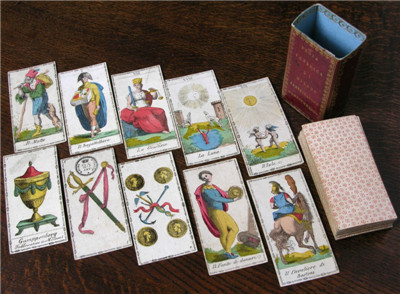Though historians like Kaplan and Matthews publish new information on divination decks every year, there are still many holes in the larger story of fortune-telling cards. Wolf points out that those who use cards for divination are often at odds with academics researching their past. “There's a lot of friction between tarot historians and card readers about the origins and purpose of tarot cards,” Wolf says. “The evidence suggests they were invented for gaming and evolved for use in divination at a much later date. Personally, I believe they were designed for game play, but that the design is a bit more sophisticated than many tarot historians seem to believe.”
盡管像Kaplan和Matthews這樣的歷史學家們每年都在推出新書,描述卡牌占卜的歷史,用卡片預知未來的歷史仍然有很多未解的地方。Wolf指出,那些仍然用卡片占卜的人與研究者之間往往不能達成一致。“關于牌的起源和意義,研究塔羅牌的歷史學家和占卜者之間經常發生摩擦,”Wolf說,“有證據表示紙牌被用于賭博和占卜是在比較晚的年代了,從個人來講我覺得它的起源就是一種游戲,但是我覺得塔羅牌的設計應該比很多歷史學家想的更復雜一些。”
By the mid-18th century, the mystical applications for cards had spread from Italy to other parts of Europe. In France, writer Antoine Court de Gébelin asserted that the tarot was based on a holy book written by Egyptian priests and brought to Europe by Gypsies from Africa. In reality, tarot cards predated the presence of Gypsies in Europe, who actually came from Asia rather than Africa. Regardless of its inaccuracies, Court de Gébelin's nine-volume history of the world was highly influential.
在十八世紀中期,卡牌的神秘用途從意大利傳播到了歐洲的其他地方。在法國,作家Antoine Court de Gébelin堅持說塔羅牌源自一本古埃及祭司的圣書,并由吉普賽人從非洲帶來。而事實上塔羅牌在歐洲的出現要早于吉普賽人,而吉普賽人實際上來自亞洲,而不是非洲。先不管這些錯誤,Court de Gébelin寫的九卷本倒是廣為傳播。
Teacher and publisher Jean-Baptiste Alliette wrote his first book on the tarot in 1791, called “Etteilla, ou L'art de lire dans les cartes," meaning "Etteilla, or the Art of Reading Cards." (Alliette created this mystical pseudonym “Etteilla” simply by reversing his surname.) According to Etteilla's writings, he first learned divination with a deck of 32 cards designed for a game called Piquet, along with the addition of his special Etteilla card. This type of card is known as the significator and typically stands in for the individual having their fortune read.
教師和出版家Jean-Baptiste Alliette在1791年寫了他的第一本關于塔羅牌的書,名為《Etteilla, ou L'art de lire dans les cartes》,意思是“艾特拉,卡片中蘊含的秘密”(Alliette發明了這個神秘學詞匯“艾特拉”,就是把他的姓的拼寫顛倒過來)。在他對“艾特拉”的描述里,他一開始是從一種叫做“皮克牌”的32張紙牌的游戲中學會占卜術的,里面再加上他特別的“艾特拉”牌,就被視為一種典型而知名的用于個人占卜的卡牌。

A hand-colored set of tarot cards produced by F. Gumppenberg, circa 1810. Photo courtesy Bill Wolf.
1810年由F. Gumppenberg制造的一種手繪塔羅牌。













